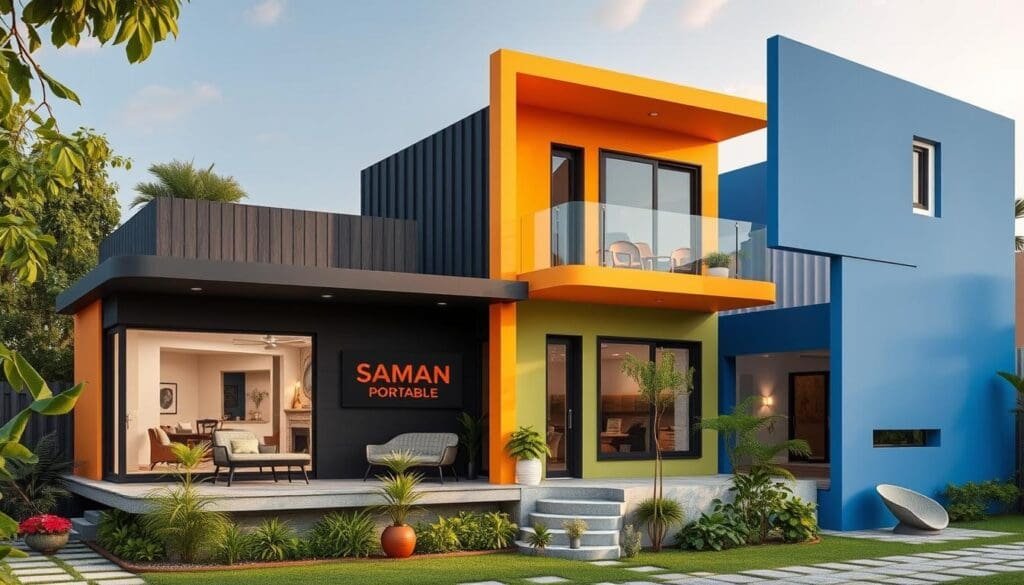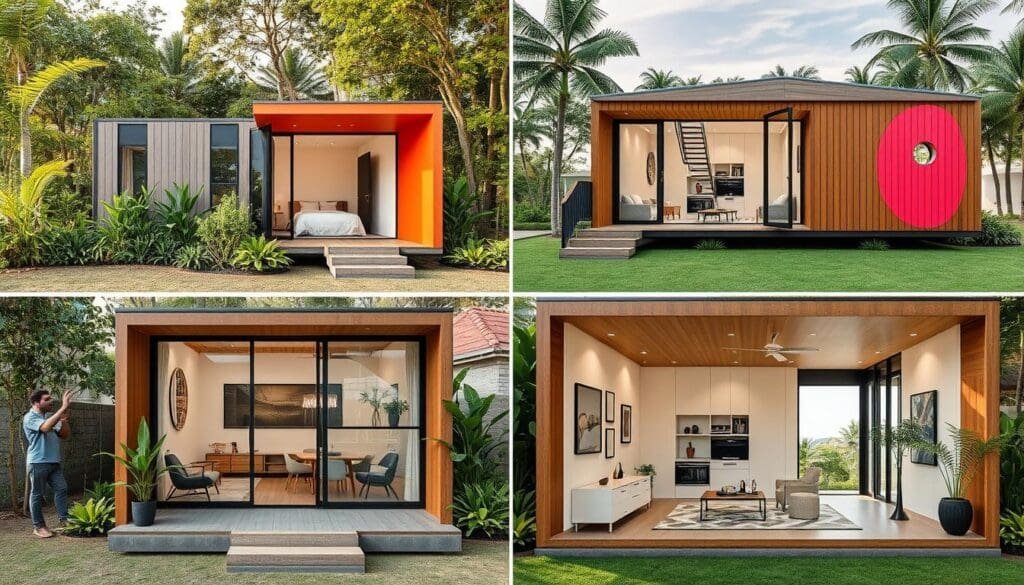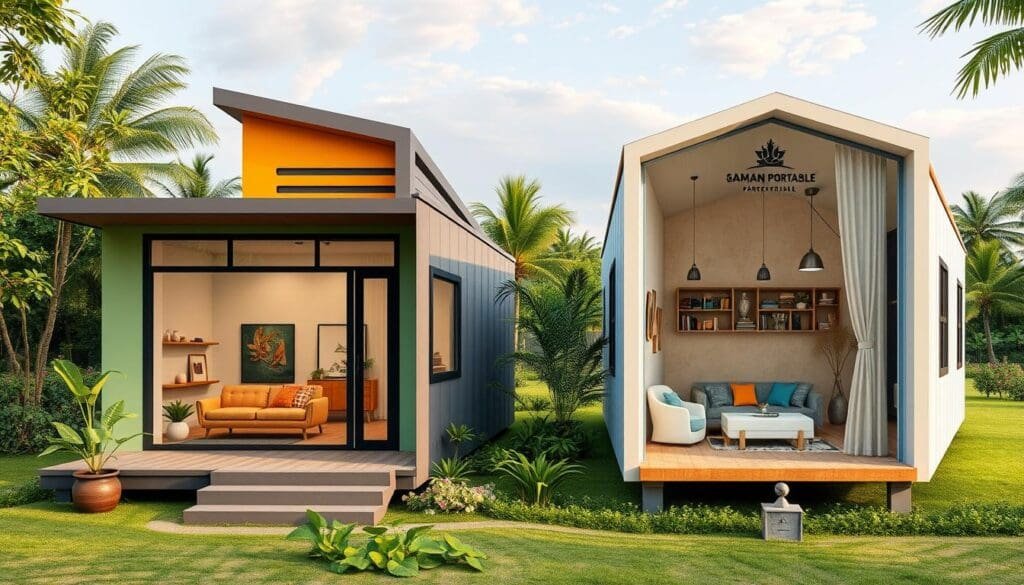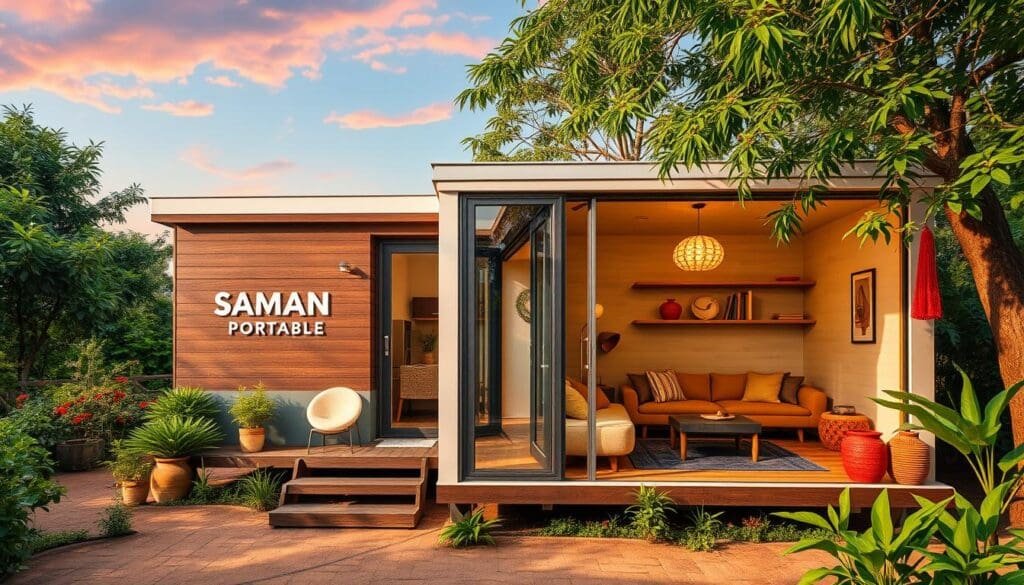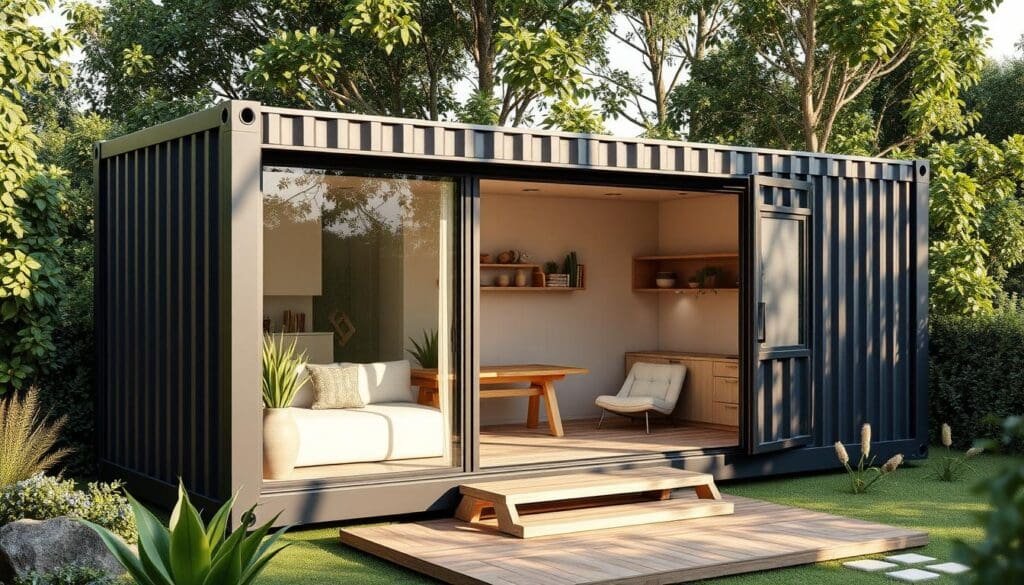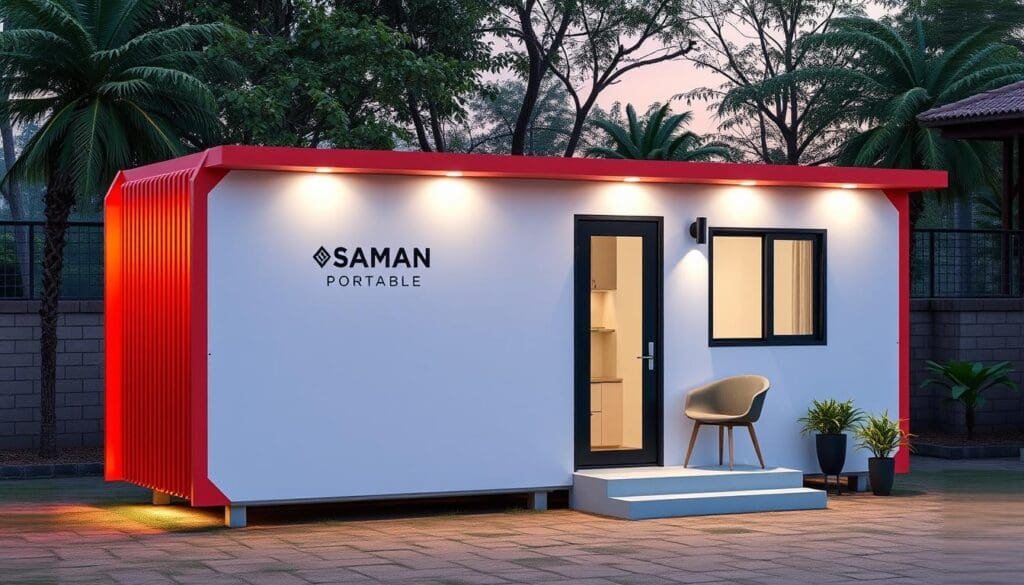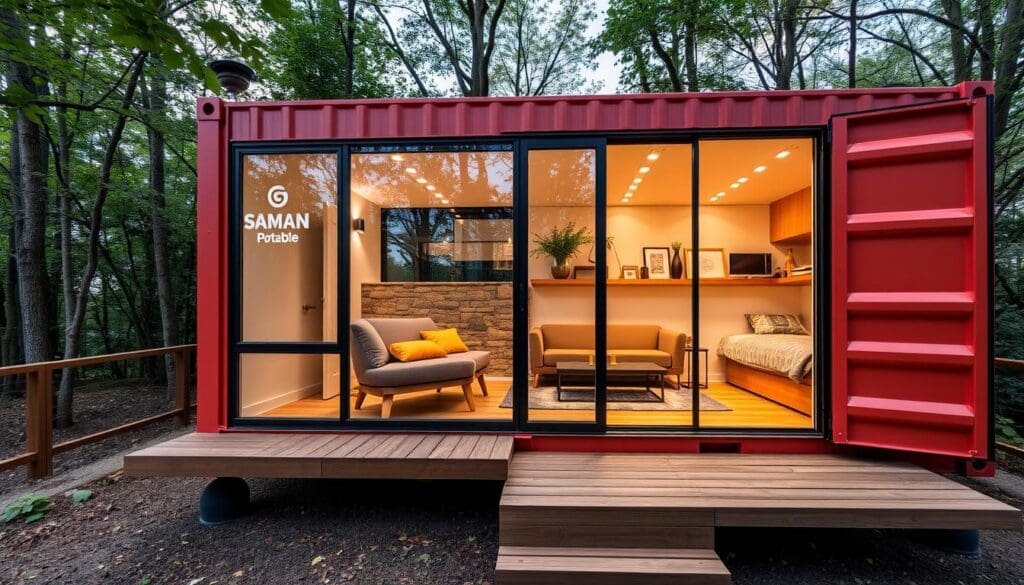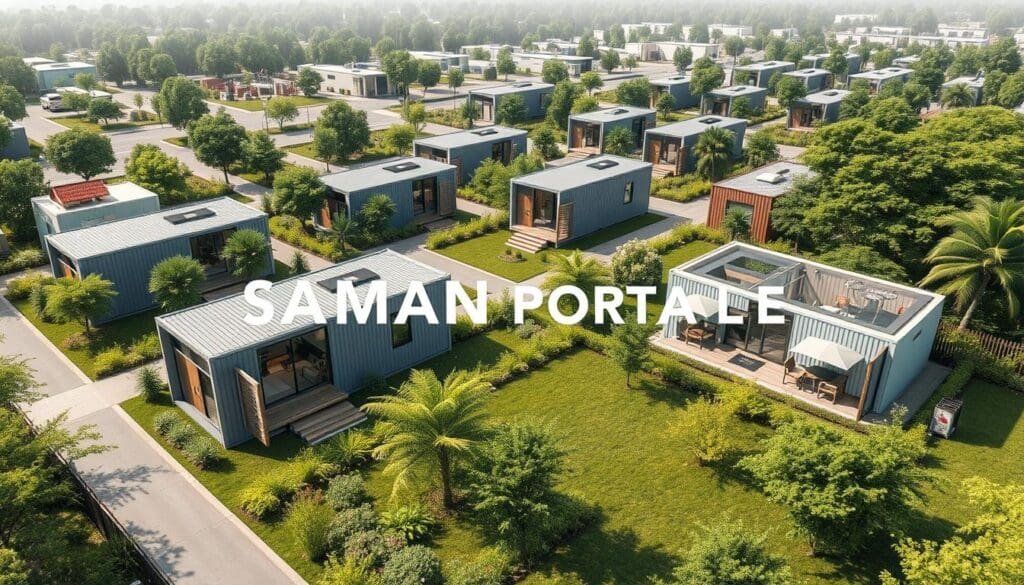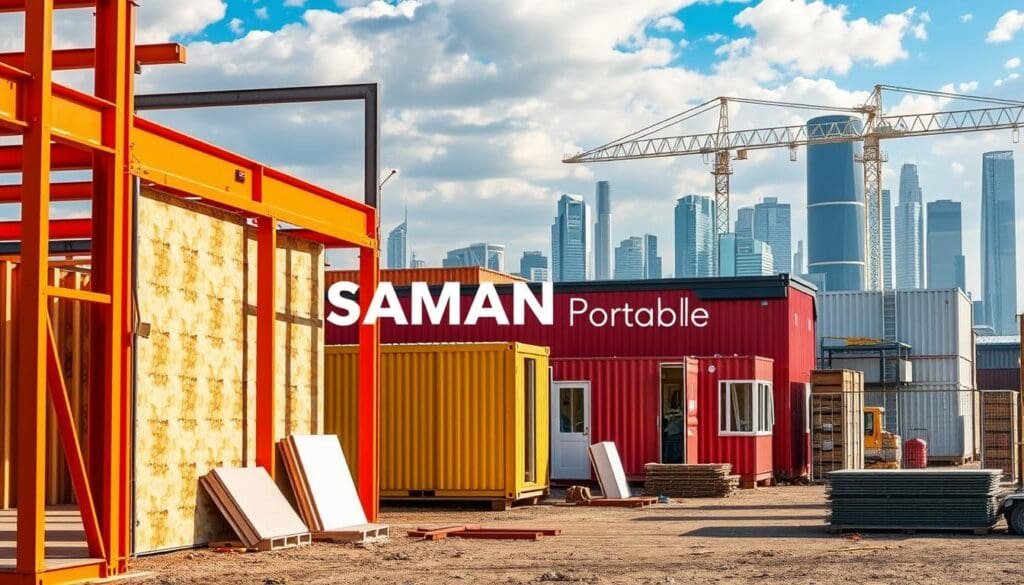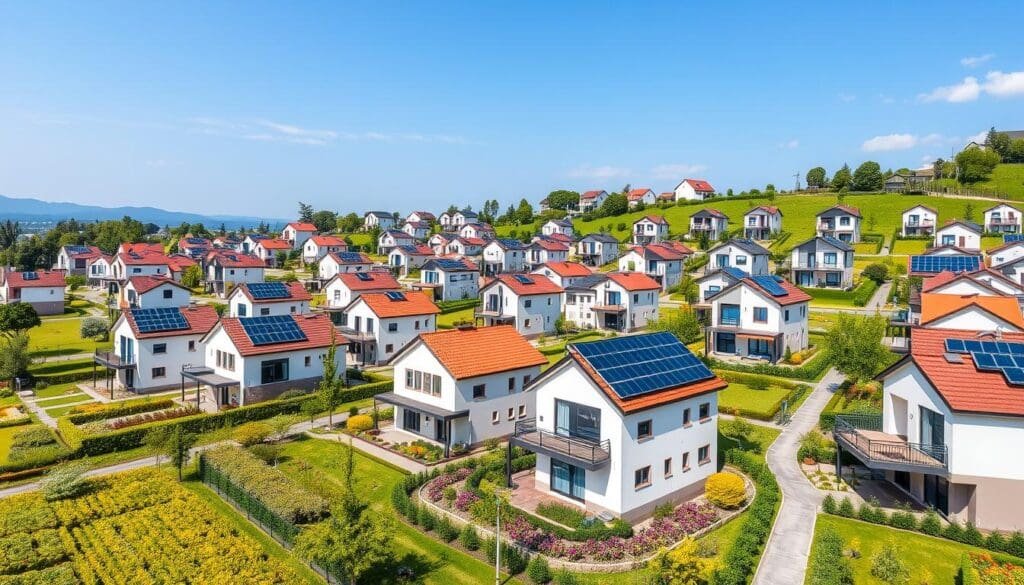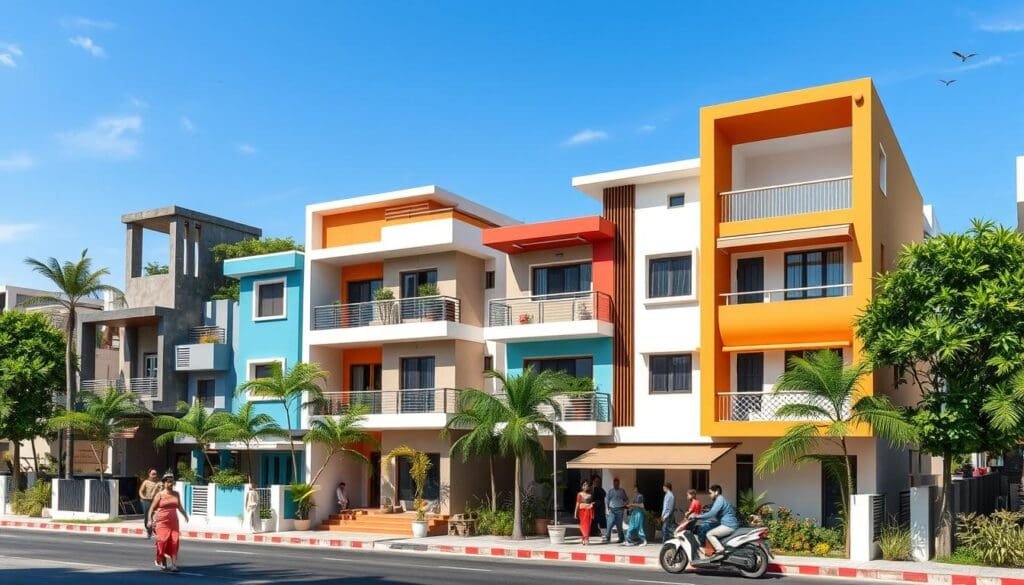Shipping Containers for Homes: Affordable, Stylish, and Sustainable Housing Solutions
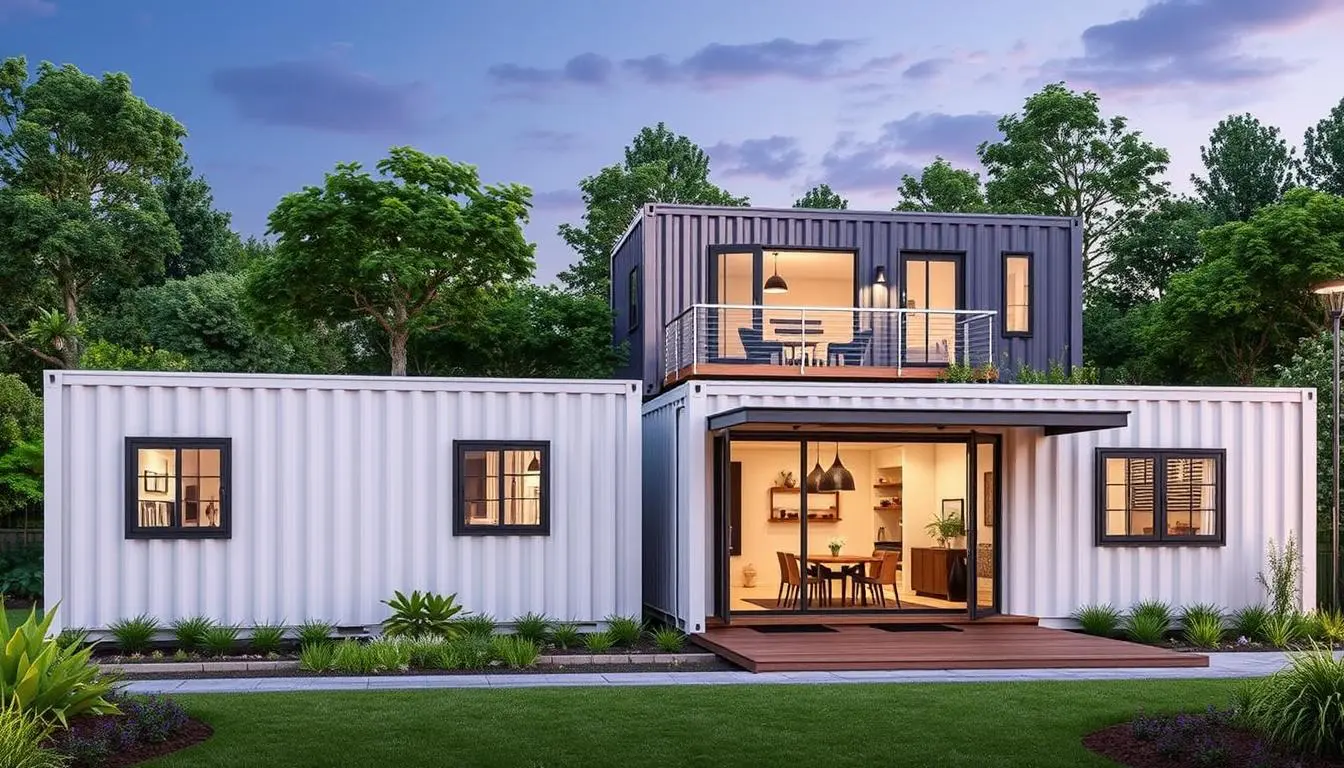
Have you ever considered living in a repurposed shipping container? While the idea may seem unconventional, container homes are quickly gaining popularity as an innovative, cost-effective, and eco-friendly housing solution. But are they truly a viable alternative to traditional homes? Let’s explore the remarkable world of shipping containers as homes and uncover why they are becoming the choice for modern, sustainable living.
Key Takeaways
- Shipping container homes offer an affordable, stylish, and sustainable housing option.
- These modular homes are constructed from repurposed shipping containers, providing a unique blend of functionality and design.
- Container homes are versatile, suitable for residential, commercial, and temporary use, with customization possibilities.
- Eco-friendly features, such as renewable energy sources and energy-efficient systems, make container homes environmentally friendly.
- Rapid installation, durability, and cost-effectiveness make container homes an attractive alternative to traditional housing in India.
Understanding Container Home Basics
Container homes are a unique and innovative housing solution that utilizes robust steel shipping containers as the foundation for construction. These versatile structures offer an array of benefits, from their durability and sustainability to their customizable design possibilities. By exploring the core components and standard specifications of container homes, we can better understand what makes them a compelling choice for modern living.
What Makes Container Homes Different
Unlike traditional houses, container homes are built using repurposed shipping containers, which are designed to withstand extreme weather conditions and harsh environments. This unique construction method enables a modular and flexible approach to home design, allowing for seamless customization and efficient use of space. Container homes also offer a more sustainable alternative to conventional housing, as they often incorporate recycled materials and energy-efficient features.
Core Components of Container Housing
The core components of a container home include the container shell, insulation, electrical and plumbing systems, and interior finishes. The container shell, typically made of sturdy steel, provides the structural foundation for the home. Insulation is crucial for regulating temperature and ensuring energy efficiency, while the electrical and plumbing systems enable modern amenities. Interior finishes, such as walls, floors, and fixtures, transform the container into a comfortable living space.
Standard Container Specifications
- Standard shipping containers come in two primary sizes: 20 feet and 40 feet long.
- The height of a standard container is typically 8 feet, with some high-cube containers reaching 9.5 feet.
- The width of a container is a consistent 8 feet, providing a modular foundation for home construction.
- Containers are designed to be stacked and transported, making them an efficient and versatile building material.
By understanding the core components and standard specifications of container homes, we can appreciate the unique value they offer in the realm of sustainable and innovative housing solutions.

The Rise of Sustainable Container Living
Container living has gained significant traction worldwide as a innovative and eco-friendly housing solution. This trend is driven by the growing demand for affordable, sustainable eco-friendly container houses that address housing shortages while prioritizing environmental consciousness.
The rise of sustainable office designs using repurposed shipping containers aligns with global efforts to reduce waste and carbon footprints. By repurposing existing materials, container homes and offices significantly minimize environmental impact, promoting a greener lifestyle through energy-efficient systems and eco-conscious features.
Container architecture, also known as “cargotecture,” has emerged as a leading innovative housing solution. Decommissioned shipping containers are transformed into versatile, customizable living and working spaces, offering a cost-effective and sustainable alternative to traditional construction methods.
- Container homes can be significantly less expensive compared to conventional real estate options, making them a financially appealing option for homeowners.
- The use of renewable energy sources, such as solar panels, and energy-efficient insulation in container homes contribute to their sustainability and reduced environmental impact.
- Container hotels and offices are becoming increasingly popular, offering guests and employees a unique, eco-conscious experience with cutting-edge designs and amenities.
As the demand for innovative eco-friendly container houses, sustainable office designs, and innovative housing solutions continues to grow, the rise of container living represents a significant step towards a more sustainable future.

Cost Benefits of Shipping Containers for Homes
Shipping container homes offer significant cost benefits compared to traditional housing options. The initial investment for a container home is often lower due to reduced material costs and shorter construction timelines. Used shipping containers can be purchased at a fraction of the cost of conventional building materials, making them an affordable office options and a cost-effective housing alternative.
Initial Investment Considerations
According to a report by Commsec Home Size Trends Report in 2020, the average size of new build homes in Australia is 235.8m2. For a standard Australian home, 18 x 20ft high cube containers would be required, amounting to a total cost of containers between $63,360 and $144,540. Alternatively, 9 x 40ft high cube containers would cost between $32,670 and $108,900. The cost variation depends on factors like quality, age, and availability of the shipping containers.
Long-term Financial Benefits
In addition to the initial cost savings, shipping container homes offer long-term financial benefits. Containers are easy to maintain, remaining in good condition for a long time with relatively little effort. They have a life expectancy of at least 20 years, and with proper maintenance, they can last even longer. This translates to lower maintenance costs compared to traditional housing, making container homes an attractive affordable prefab houses option.
Comparison with Traditional Housing Costs
Building a shipping container home typically requires less labor than constructing a traditional house, which can result in lower overall construction costs. Furthermore, the customizable square footage of container homes, ranging from a standard 20-foot container to a 40-foot high cube container, allows for cost-effective solutions that cater to various budgets and needs. This makes shipping container homes a compelling cost-effective housing alternative for those seeking affordable office options.

Design Possibilities and Architectural Innovation
Shipping container homes are revolutionizing the world of modern office spaces and stylish living solutions. These innovative housing options offer a canvas for remarkable architectural creativity, transcending their original purpose as cargo transportation units. Designers can transform simple shipping containers into stunning, functional spaces that seamlessly blend form and function.
Port Shipping Containers, a pioneering Australian company, showcases the remarkable potential of repurposed shipping containers. Throughout the country, both businesses and individuals have embraced container architecture, recognizing its ability to create functional and aesthetically pleasing spaces. From trendy cafes and portable offices to emergency shelters and custom container homes, the versatility of these structures is truly remarkable.

Port Shipping Containers excels in crafting customized solutions tailored to the unique requirements of each client. By leveraging the modular characteristics of containers, designers can create innovative architectural compositions that maximize natural light, space utilization, and even incorporate rooftop gardens or patios for outdoor living areas.
Shipping container conversions not only contribute to reducing waste and promoting recycling but also offer cost-effective solutions for creating sustainable and stylish spaces. The company plays a pivotal role in waste reduction by repurposing used shipping containers into environmentally conscious structures, contributing to the circular economy by minimizing resource consumption and maximizing the lifespan of these versatile building blocks.
Construction Process and Timeline
The construction process for efficient container offices, prefab office cabins, and container workspaces is often faster than traditional building methods. The timeline can vary depending on various factors, but with careful planning and execution, these versatile container-based structures can be up and running in a matter of weeks.
Site Preparation Requirements
The first step in the construction process involves preparing the site. This typically includes creating a suitable foundation, such as a concrete slab or piers, to ensure the stability and longevity of the container-based structure. The duration of this site preparation phase can range from 4 to 7 weeks, depending on the complexity of the project and local building codes.
Installation Steps
Once the site is ready, the installation of the prefab office cabins or container workspaces can begin. This stage involves precisely positioning the containers, securing them to the foundation, and connecting multiple units if required. The duration of this installation phase can vary between 3 to 9 weeks, depending on the project’s scale and the level of customization.
Finishing Touches
The final stage of the construction process focuses on the finishing touches, including interior work such as insulation, electrical and plumbing installation, and applying interior and exterior finishes. This phase can take from 2 to 13 weeks, depending on the level of customization and the complexity of the project.
Overall, the construction timeline for efficient container offices, prefab office cabins, and container workspaces can range from a few weeks to several months, depending on the project’s specific requirements and the level of customization involved. By planning meticulously and leveraging the inherent benefits of container-based construction, these solutions can provide a faster and more efficient path to creating high-quality, sustainable office spaces.

Environmental Impact and Sustainability Features
Shipping container homes have a significantly reduced environmental impact compared to traditional construction methods. These innovative eco-friendly container houses repurpose existing materials, minimizing the demand for new resources and preventing discarded containers from ending up in landfills. The use of recycled shipping containers not only supports sustainable living but also contributes to the circular economy by giving new life to these durable steel structures.
Many container home designs incorporate sustainable features that further enhance their environmental benefits. Solar panels are commonly installed, harnessing renewable energy to power these homes and reduce reliance on fossil fuels. Rainwater harvesting systems and energy-efficient appliances are also popular additions, enabling residents to conserve precious natural resources and lower their carbon footprint. The inherent thermal insulation properties of shipping containers can also minimize the need for excessive heating or cooling, resulting in long-term energy savings and a more sustainable living experience.
While the construction of eco-friendly container houses may require some modifications to enhance their livability, the overall sustainability features make them a compelling choice for those seeking to reduce their environmental impact. Similarly, sustainable office designs utilizing shipping containers offer a unique and innovative approach to creating modern, energy-efficient workspaces that prioritize sustainability and conservation.

The durability and longevity of shipping containers also contribute to the sustainability of container homes. These structures are built to withstand harsh conditions, requiring fewer repairs and renovations over time, further reducing the environmental impact associated with traditional construction. As the demand for sustainable living solutions continues to grow, the eco-friendly features and repurposed nature of container homes make them an increasingly attractive option for those who prioritize environmental responsibility and resource conservation.
Customization Options and Interior Design
Modern container homes offer a wealth of customization options and interior design possibilities. The versatility of shipping containers allows homeowners to create unique living spaces tailored to their specific needs and preferences. From simple studio-style layouts to complex multi-container designs, the layout planning process is crucial in optimizing the available space.
Layout Planning
When it comes to layout planning, container homes offer a range of options. Homeowners can choose from open-concept floor plans, dedicated living and sleeping areas, or even multi-level designs that maximize the vertical space. The use of modular and multi-functional furniture further enhances the flexibility of these customizable container homes.
Material Selection
The material selection for container home interiors often focuses on sustainable and durable options that complement the industrial aesthetic of the shipping containers. Customizable container homes may feature a blend of natural materials, such as wood and stone, alongside modern, energy-efficient finishes to create a harmonious and visually appealing living environment.
Space Optimization Techniques
- Efficient use of storage solutions, such as built-in cabinetry and shelving, to maximize the available space
- Incorporation of multi-functional furniture, such as transformable tables, Murphy beds, and space-saving appliances
- Strategic placement of windows, skylights, and doors to enhance natural lighting and ventilation
- Thoughtful room divisions and zoning to create distinct living, sleeping, and work areas within the modern container homes

By leveraging these customization options and interior design strategies, homeowners can create highly functional and visually appealing living spaces within the unique confines of a shipping container. The combination of efficient layout planning, sustainable material selection, and innovative space optimization techniques allows for the creation of truly remarkable customizable container homes.
Structural Durability and Weather Resistance
Shipping containers are inherently durable, designed to withstand the rigors of ocean transport. This structural integrity makes them an excellent choice for durable housing options and containers for shipping. The steel construction, comprising JIS SPA-H weathering steel, provides exceptional resistance to wind, rain, and even seismic activity.
Shipping containers are engineered to hold up to 480,560 pounds on their corner castings, showcasing their robust load-bearing capabilities. The weathering protection of the Corten steel, which forms a protective rust layer, contributes to the long-term value retention of these structures, with an estimated 75% retention for at least 25 years.
The corrugated steel walls of shipping containers are inherently strong, resisting deformation under pressure from high winds or storms. In flood-prone areas, the elevated foundations keep living spaces above flood levels, protecting the home and belongings from water damage. Additionally, shipping container homes can withstand winds up to 175 mph during hurricane season, making them safer than many traditional buildings.
The load-bearing capabilities of shipping containers also make them suitable for areas with heavy snowfall. They can support significant weight on their corners, effectively distributing heavy snow loads and reducing the risk of roof collapse.

Overall, the structural durability and weather resistance of shipping containers make them a reliable and resilient choice for durable housing options and containers for shipping. With proper maintenance and protective coatings, these versatile structures can provide long-lasting, weather-resistant homes for decades to come.
Legal Considerations and Building Codes
As the interest in office container for sale and containers as offices grows, it’s crucial to navigate the legal landscape and building codes before embarking on a container home project. In India, the legal framework surrounding these non-traditional housing structures is still evolving, presenting both challenges and opportunities for homeowners.
Zoning Requirements
Local zoning laws play a crucial role in determining the feasibility of container homes. These regulations can vary significantly across different regions, often restricting the use of unconventional housing structures. Consulting with local authorities and understanding the zoning requirements is essential to ensure compliance and avoid potential roadblocks during the construction process.
Permit Processes
Obtaining the necessary permits for a container home project can be a complex and detailed process. Homeowners may need to submit comprehensive plans, drawings, and specifications to local authorities for review and approval. Working with experienced professionals, such as structural engineers or architects, can help navigate the permit process more efficiently and ensure that the container home meets all safety and building code standards.
Safety Regulations
Container homes must adhere to rigorous safety regulations, including structural integrity, electrical systems, plumbing, and fire safety. The National Building Code in India sets out minimum requirements for habitable spaces, and container house designs need to be assessed by qualified professionals to ensure compliance. Adhering to these safety standards is not only a legal requirement but also crucial for the well-being of the occupants.
As the concept of office container for sale and containers as offices continues to gain traction in India, the need for clear guidelines and regulations becomes increasingly important. By staying informed about the legal considerations and building codes, homeowners can navigate the process more effectively and contribute to the sustainable growth of container home construction in the country.

Insulation and Climate Control Solutions
As businesses and individuals increasingly explore the benefits of sustainable office designs using shipping containers, proper insulation and climate control solutions have become crucial considerations. Maintaining comfortable indoor temperatures and energy efficiency are vital for creating a productive and comfortable working environment within these efficient container offices.
Spray foam insulation is a popular choice for container homes and offices, providing exceptional thermal performance and air sealing capabilities. Rigid foam boards and natural materials like wool or hemp are also viable options, each offering unique benefits in terms of R-value, moisture resistance, and eco-friendliness.
In addition to insulation, climate control solutions often incorporate energy-efficient HVAC systems, passive solar design principles, and strategically placed windows for natural ventilation. These measures help regulate indoor temperatures, reduce energy consumption, and create a comfortable living or working environment, even in challenging climates.
- Spray foam insulation: Provides superior thermal and air sealing performance.
- Rigid foam boards: Offer excellent R-value and can be customized for container dimensions.
- Natural insulation: Options like wool or hemp provide eco-friendly alternatives with good thermal properties.
- Energy-efficient HVAC systems: Incorporate smart technology to optimize energy usage and comfort.
- Passive solar design: Strategically placed windows and building orientation to harness natural light and ventilation.
By combining effective insulation techniques and climate control solutions, container-based offices and living spaces can achieve exceptional energy efficiency and comfort, making them a sustainable and attractive option for modern businesses and homeowners.
Modern Amenities and Smart Home Integration
As the world embraces innovative housing solutions, container homes have emerged as a versatile and sustainable option. These modular structures not only offer an affordable and eco-friendly alternative but also boast the integration of modern amenities and smart home technologies. Container homes in the UAE are at the forefront of this technological revolution, catering to the evolving needs of modern homeowners.
Technology Implementation
Container homes in the UAE are equipped with cutting-edge technology that enhances the living experience. High-speed internet connectivity, smart lighting systems, and advanced security features are just a few of the innovations that can be seamlessly integrated into these modular structures. These technological advancements transform container homes into intelligent spaces, offering residents unparalleled convenience and control.
Energy Management Systems
Sustainability is a cornerstone of the container home lifestyle, and energy management systems play a crucial role in this. Container homes in the UAE are designed to incorporate renewable energy sources, such as solar panels, and energy-efficient appliances. These advanced systems monitor and optimize power consumption, ensuring that residents enjoy a reduced carbon footprint and lower utility costs.
Home Automation Options
- Remote control of heating, cooling, and lighting systems
- Integrated security features, including smart locks and surveillance cameras
- Automated irrigation systems for water conservation
- Voice-activated commands for hands-free control of home functions
The integration of home automation options in container homes in the UAE elevates the living experience, offering residents a seamless and energy-efficient lifestyle. From the convenience of remote control to the peace of mind provided by advanced security features, these smart home technologies redefine the way we inhabit our living spaces.
As the demand for modern and sustainable housing solutions continues to grow, container homes in the UAE are at the forefront of this revolution. By seamlessly integrating cutting-edge technologies and energy-efficient systems, these innovative living spaces are shaping the future of modern office spaces and container office solutions, providing residents with a truly remarkable and eco-conscious living experience.
Maintenance Requirements and Longevity
When it comes to durable housing options and portable office containers, maintenance is key to ensuring longevity. Shipping containers, the foundation of container homes and offices, are naturally resistant to pests and rot, but they still require regular attention to preserve their structural integrity and aesthetic appeal.
One of the essential maintenance tasks for container homes and offices is inspecting and maintaining the exterior coating to prevent rust. Proper application of rust-prevention paint, especially on areas directly exposed to rain and sun, can significantly extend the lifespan of these durable housing options. Shipping containers can last up to approximately 25 years if maintained properly, potentially doubling their lifespan.
- Regular cleaning and maintenance, including clearing debris and checking for cracks, can contribute to the longevity of container homes and offices.
- Sealing all modifications and openings properly to prevent moisture seepage is crucial to avoid rusting and other water-related issues.
- Strong foundations, such as concrete piers or slabs, are essential for container homes to prevent sinking over time.
In addition to the external maintenance, interior systems also require regular attention. Plumbing, electrical, and climate control systems should be regularly inspected and serviced to ensure optimal performance and safety. Expert maintenance and repair services can save time and money by avoiding downtime.
With proper care and maintenance, container homes and portable office containers can have a lifespan comparable to or even exceeding that of conventional structures. By investing in regular upkeep, these durable housing options and portable office solutions can provide reliable and long-lasting solutions for both residential and commercial needs.
Investment Potential and Market Value
Container homes present a unique investment opportunity in the housing market. Their lower construction costs and potential for appreciation make them attractive to investors and homeowners alike. The global shipping container market was valued at US $14 billion in 2022 and is projected to grow at a compound annual growth rate of 4.68%, reaching over US $18.2 billion by 2027.
The market value of container homes can vary depending on location, design quality, and local real estate trends. As the popularity of alternative housing solutions grows, well-designed and strategically located container homes may see increased demand and value appreciation over time. The container homes market size was valued at USD 61.83 billion in 2023 and is projected to reach USD 108.70 billion by 2032, exhibiting a CAGR of 6.7%.
Container homes are becoming popular due to their sustainability and cost-effectiveness, driving market growth. The demand for well-equipped homes is rising post-COVID-19, further boosting the market. Container homes offer affordable office options and container housing solutions that are increasingly attractive in regions with high housing costs.
The container home market growth is hindered by limited lifespan and high susceptibility to corrosion due to climatic conditions. However, fixed container homes and movable container houses are expected to grow considerably, catering to the diverse needs of homebuyers and investors.
Investors have reported making two to five times more money on well-located short-term vacation rental properties compared to long-term investments. Container homes are noted to maintain a high resale value, often exceeding 100%, making them a compelling investment option.
Conclusion
Shipping container homes have emerged as a compelling solution to the global housing crisis, offering a unique blend of affordability, sustainability, and innovative design. These versatile structures leverage the strength and durability of repurposed shipping containers to provide cost-effective and eco-friendly living spaces.
From reduced construction costs and quicker build times to enhanced energy efficiency and a smaller environmental footprint, shipping container homes present a range of advantages that are increasingly resonating with homeowners, developers, and urban planners alike. As the demand for sustainable and accessible housing continues to grow, these innovative dwelling solutions are poised to play a significant role in shaping the future of residential architecture.
Whether you’re a first-time homebuyer, an eco-conscious individual, or an investor seeking unique property opportunities, shipping container homes offer a compelling alternative to traditional construction methods. By embracing this innovative approach to housing, we can pave the way for a more sustainable and inclusive future, where quality living spaces are accessible to all.
FAQ
What makes container homes different from traditional houses?
Container homes are constructed from repurposed shipping containers, offering a unique blend of functionality and style. They differ from traditional houses in their construction method, sustainability features, and potential for mobility.
What are the core components of a container home?
The core components of a container home include the container shell, insulation, electrical and plumbing systems, and interior finishes.
What are the standard sizes of shipping containers used in container homes?
Standard shipping containers typically come in 20 or 40 feet lengths, providing a modular foundation for container home construction.
How have container homes contributed to sustainable living?
Container homes are eco-friendly, utilizing recycled materials and energy-efficient systems. They significantly reduce waste and environmental impact by repurposing existing materials.
What are the initial investment and long-term financial benefits of container homes?
Container homes often have a lower initial investment due to reduced material costs and shorter construction timelines. They also offer long-term financial benefits, including lower maintenance costs and potential energy savings.
What design possibilities and architectural innovations are possible with container homes?
Container homes offer vast design possibilities, allowing designers to create modern, stylish living spaces by combining multiple containers or modifying single units. They also provide opportunities for innovative layouts and the incorporation of outdoor living areas.
How does the construction process for container homes differ from traditional building methods?
The construction process for container homes is typically faster than traditional building methods. It involves site preparation, positioning the containers, securing them to the foundation, and completing the interior finishes.
What sustainable features are commonly incorporated in container homes?
Many container homes incorporate sustainable features such as solar panels, rainwater harvesting systems, and energy-efficient appliances, reducing the home’s carbon footprint and contributing to long-term energy savings.
How can container homes be customized and designed for optimal interior space?
Container homes offer extensive customization options, allowing for layout planning, material selection, and the use of space optimization techniques like multi-functional furniture and built-in storage solutions.
How durable and weather-resistant are container homes?
Shipping containers are inherently durable and weather-resistant, providing excellent protection against extreme weather events. With proper maintenance and protective coatings, container homes can have a lifespan comparable to or exceeding that of traditional wooden structures.
What legal considerations and building code requirements should be addressed when constructing a container home?
Before constructing a container home, it’s crucial to navigate local zoning laws and building codes, which may have specific requirements for non-traditional housing structures. The permit process often involves submitting detailed plans and obtaining approvals from local authorities.
How can container homes be efficiently insulated and climate-controlled?
Proper insulation, energy-efficient HVAC systems, and passive solar design principles are crucial for maintaining comfortable indoor temperatures and energy efficiency in container homes, regardless of the climate.
What modern amenities and smart home technologies can be integrated into container homes?
Container homes can be equipped with high-speed internet connectivity, smart lighting systems, advanced security features, and energy management systems that optimize power consumption and integrate with renewable energy sources.
What are the typical maintenance requirements and longevity of container homes?
Container homes require regular maintenance to ensure longevity and optimal performance, such as inspecting and maintaining the exterior coating, checking seals, and maintaining the roof. With proper care, container homes can have a lifespan comparable to or exceeding that of conventional houses.
What are the investment potential and market value considerations for container homes?
Container homes present a unique investment opportunity in the housing market, with their lower construction costs and potential for appreciation. The market value can vary depending on location, design quality, and local real estate trends.
 Container Cafe
Container Cafe
















































































